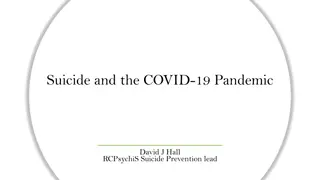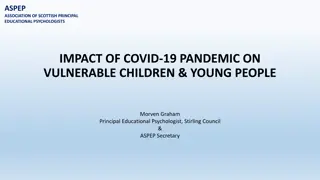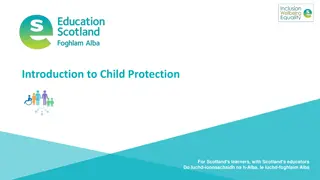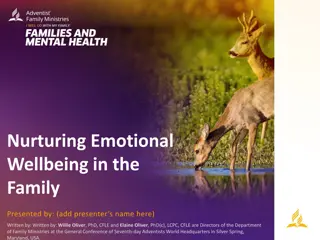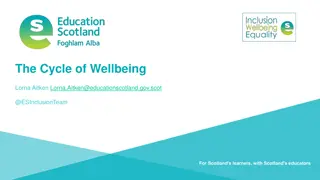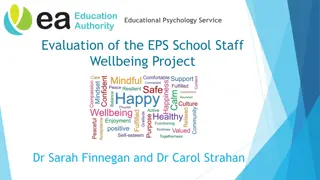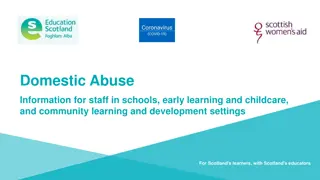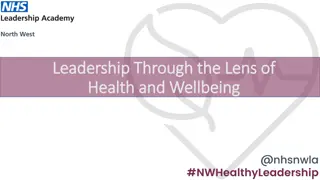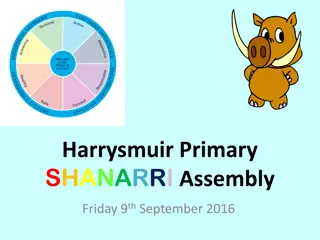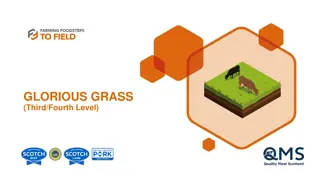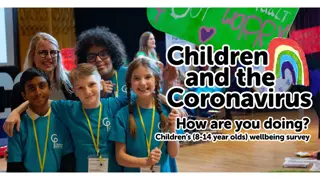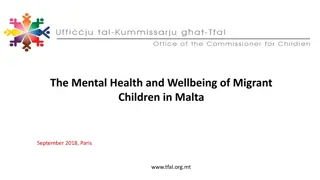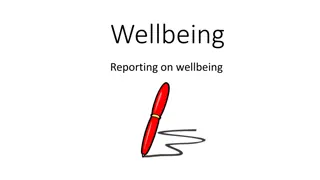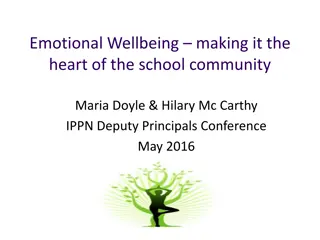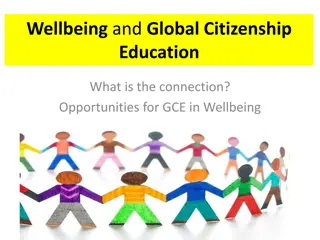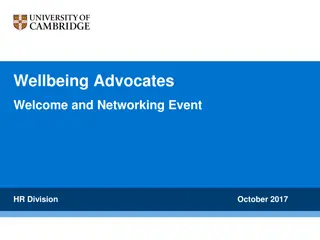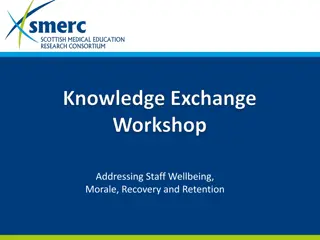Analysis of Young Children's Wellbeing During the Pandemic in Scotland
Conducted in June 2021, a comprehensive study in Scotland examined the impact of the pandemic on young children and their families. The research covered various aspects including child demographics, activities, home learning environment, parental demographics, pandemic experiences, child health, and parental wellbeing. The study utilized surveys to gather data from over 11,000 participants, highlighting potential biases in sample representation. Findings from the Strengths and Difficulties Questionnaire (SDQ) indicate noteworthy trends in child behavior and parental mental wellbeing between rounds of data collection.
Uploaded on Oct 11, 2024 | 0 Views
Download Presentation

Please find below an Image/Link to download the presentation.
The content on the website is provided AS IS for your information and personal use only. It may not be sold, licensed, or shared on other websites without obtaining consent from the author. Download presentation by click this link. If you encounter any issues during the download, it is possible that the publisher has removed the file from their server.
E N D
Presentation Transcript
Young Children during Young Children during the Pandemic the Pandemic June 2021
Online convenience survey of parents/carers of children aged 27 Open recruitment through social media and networks including LA & third sector Aims to establish how living through the pandemic has affected the health and wellbeing of young children and their families in Scotland Round 1: 11,288 responses Round 2: 5,684 All local authorities represented (not equally) Biases less parents from lower incomes, fewer BAME children and less young parents
What has CEYRIS covered to date? Child demographics Age, sex, ethnicity Child s activities Play, organised activities, school/childcare, use of outdoors, meeting friends/family, Home Learning Environment (HLE) Parent demographics Relationship to child, age, languages spoken, household income, employment status, local authority (LA) Experience of children s services We asked about need, access and reasons for not accessing Household demographics Home ownership, no. bedrooms, no, adults, no. children, access to outside space at home, access to good quality greenspace nearby Experience of pandemic Face coverings, isolation, child s relationship with others, clinically vulnerable household members, bereavement Child health, wellbeing and development Long term conditions (LTC), type of LTC & Impact of LTC, Sleep, Strengths and Difficulties Questionnaire (SDQ) Parental experience Mental Wellbeing (SWEMWBS), LTC, impact on employment, impact on income (& impact of reduced income)
Strengths and Difficulties Questionnaire (SDQ) scores SDQ Total Difficulty Scores 2-3 year olds base 1,505 100 90 80 70 60 50 40 30 20 10 0 Close to average Slightly raised High Very high Round 1 Round 2 SSELC
Strengths and Difficulties Questionnaire (SDQ) scores SDQ Total Difficulty Scores 4-7 year olds base: 3,215 90 80 70 60 50 40 30 20 10 0 Close to average Slightly raised High Very high Round 1 Round 2 SSELC
Experience of parents Mental Wellbeing SWEMWEBS Scores 30 25 20 15 10 5 0 Round 1 Round 2 SSELC
Impact on income In June/July 2020, 44% of children experienced a reduction in their household income. Low and medium income households were disproportionately impacted In November/December 2020 35% of children experienced a reduction in their household income 10% of families who had reduced income said they struggled to provide food for their families
Use of outdoor spaces Played outside (outwith school/childcare) 100 90 80 70 Percentage of sample 60 50 43 43 38 40 27 30 18 20 16 15 10 1 - Every day Most days Somedays None at all Round 2 Round 1 Base for Round 2: 4,107 Base for Round 1: 9,429
Relationships How often in the last week has your child spoken to family (outside of school/childcare) 100 90 80 70 Percentage of sample 60 52 49 50 40 30 26 20 17 20 14 14 9 10 - Every day Most days Somedays None at all Round 2 Round 1 Base for Round 2: 4,070 Base for Round 1: 9,429
Relationships How would you rate changes to the quality of your child's relationship with the following groups, compared to before the coronavirus pandemic? *excludes PNTS and NA Close family members outside the child's main household (for example, parents or siblings that the child does not live with full-time) (base: 1,122) 100 90 80 70 Percentage of sample 57 60 50 40 30 30 20 8 10 4 2 - Much worse Worse About the same Better Much better Percentage of sample
Relationships How would you rate changes to the quality of your child's relationship with the following groups, compared to before the coronavirus pandemic? *excludes PNTS and NA Grandparents (base: 3,651) 100 90 80 70 Percentage of sample 60 53 50 40 28 30 20 7 7 10 4 - Much worse Worse About the same Better Much better
Experience of bereavement Have you or your child experienced the death of close family or friends (for any reason) since the beginning of the coronavirus pandemic? (base:3,760) 100 90 80 80 70 Percentage of sample 60 50 40 30 20 16 10 5 - Yes, related to coronavirus and the restrictions Yes, other causes No
Self-Isolation Since August, has your child had to self-isolate for a short period of time (less than one week) while they, or a close contact, waited for test results? (base: 3,780) 100 90 80 69 70 Percentage of sample 60 50 40 31 30 20 10 - Yes No
Limited use of services Percentage of sample who reported that they did not need access to each service 100 90 80 70 60 50 40 30 20 10 0 Health Visitor GP Allied Health Professional School staff Childcare staff Family Support Worker Social Worker Voluntary or community staff Food Insecurity Out of Hours GP A&E Dentist Round 1 Round 2
Limited use of services Percentage of those who would have liked to use each service but did not 100 90 80 74 70 59 Percentage (%) 57 60 50 49 50 44 40 34 33 30 29 27 30 22 18 17 20 13 13 11 10 9 10 4 0 Health Visitor GP Allied Health Professional School staff Childcare staff Family Support Worker Social Worker Voluntary or community staff Food Insecurity Out of Hours GP A&E Dentist Round 1 Round 2
Schools and childcare Of those who wanted to speak to school staff Please select the option below that best represents your experience of this service? 100 90 80 76 70 66 Percentage (%) 60 50 40 30 21 18 20 13 7 10 0 I would have liked to speak with school staff, but I have not I have spoken with school staff online / by telephone (for example, phone call, video call or email) I have spoken with school staff face-to-face Round 1 Round 2 Base for Round 2: 1, 401 Base for Round 1: 2,969
Schools and childcare: those who wanted or needed to speak with nursery/childcare staff Please select the option below that best represents your experience of this service? (base: 971) 100 90 80 70 59 Percentage (%) 60 46 50 43 40 28 30 20 13 11 10 0 I would have liked to speak with nursery staff or childminder, but I have not I have spoken with nursery staff or childminder online or by telephone (for example, phone call, video call or email) I have spoken with nursery staff or childminder face-to-face Round 1 Round 2 Base for Round 2: 971 Base for Round 1: 2,360
Health Visitor Services: those who wanted or needed to access Health Visitor services Please select the option below that best represents your experience of this service? 100 90 80 70 Percentage of sample 60 54 50 43 40 40 30 30 17 20 15 10 0 I would have liked to use this service, but I did not I have used this service online / by telephone (for I have used this service face-to-face example, phone call, video call or email) Base for Round 2: 608 Base for Round 1: 967
Use of Acute services by children Under 5 years 2020 Scotland 0 Ambulance NHS24 Emergency Admissions ED Out of Hours Primary Care -10 -20 -29 -30 -37 -40 -40 -50 -53 -60 -63 -70
2020 presentations at ED - Under 5s 120 100 80 60 40 20 0 Dermatology ENT Gastrointestinal Genito-urinary Infection Musculoskeletal Neurology Nothing abnormal detected Obstetrics Ophthalmology Respiratory Social circumstances Trauma/injury/poisoning Other No info on diagnosis Total 2020 as proportion of 2018/19 baseline 2918/19 baseline 20
More families than before, more stresses than before Around 40% of children living in households where income has reduced 30% of children have had to self- isolate at least once Parental Wellbeing scores very low Higher proportion of parents reporting concerns with child s behaviour and wellbeing Increased family stress 1 in 5 children have experienced bereavement during the pandemic As time goes on and weather worsens less children and getting out and about frequently Reduced social contacts outside of the home Small proportion of parents reporting worsening family relationships




